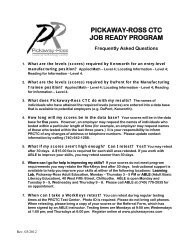Commons
Conceptual Physics - elearning-phys
Conceptual Physics - elearning-phys
- No tags were found...
Create successful ePaper yourself
Turn your PDF publications into a flip-book with our unique Google optimized e-Paper software.
initial position with the same kinetic energy and the same directionof motion. The motion has gone through one complete cycle, andwill now repeat forever in the absence of friction.The usual physics terminology for motion that repeats itself overand over is periodic motion, and the time required for one repetitionis called the period, T . One complete repetition of the motion iscalled a cycle.We are used to referring to short-period sound vibrations as“high” in pitch, and it sounds odd to have to say that high pitcheshave low periods. It is therefore more common to discuss the rapidityof a vibration in terms of the number of vibrations per second,a quantity called the frequency, f. Since the period is the numberof seconds per cycle and the frequency is the number of cycles persecond, they are reciprocals of each other,f = 1/T .Units of inverse second, s −1 , are awkward in speech, so an abbreviationhas been created. One Hertz, named in honor of a pioneerof radio technology, is one cycle per second. In abbreviated form,1 Hz = 1 s −1 . This is the familiar unit used for the frequencies onthe radio dial.Frequency of a radio station example 1⊲ KKJZ’s frequency is 88.1 MHz. What does this mean, and whatperiod does this correspond to?⊲ The metric prefix M- is mega-, i.e., millions. The radio wavesemitted by KKJZ’s transmitting antenna vibrate 88.1 million timesper second. This corresponds to a period ofT = 1/f = 1.14 × 10 −8 s .b / 1. The amplitude of thevibrations of the mass on a springcould be defined in two differentways. It would have units ofdistance. 2. The amplitude of aswinging pendulum would morenaturally be defined as an angle.This example shows a second reason why we normally speak interms of frequency rather than period: it would be painful to haveto refer to such small time intervals routinely. I could abbreviateby telling people that KKJZ’s period was 11.4 nanoseconds, butmost people are more familiar with the big metric prefixes thanwith the small ones.Units of frequency are also commonly used to specify the speedsof computers. The idea is that all the little circuits on a computerchip are synchronized by the very fast ticks of an electronic clock, sothat the circuits can all cooperate on a task without getting aheador behind. Adding two numbers might require, say, 30 clock cycles.Microcomputers these days operate at clock frequencies of about agigahertz.We have discussed how to measure how fast something vibrates,but not how big the vibrations are. The general term for this is164 Chapter 8 Waves



